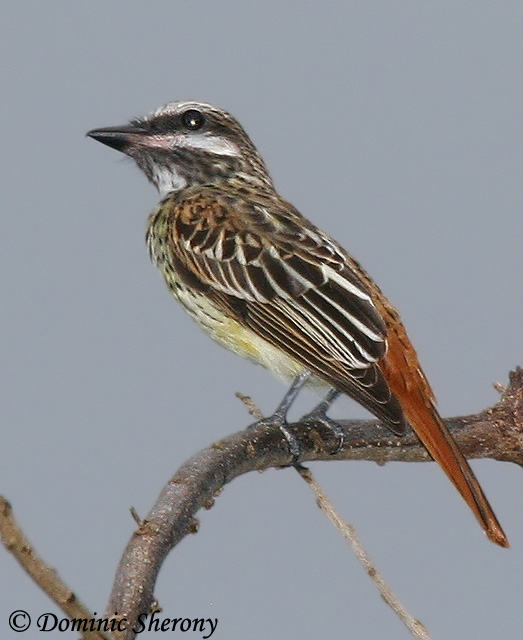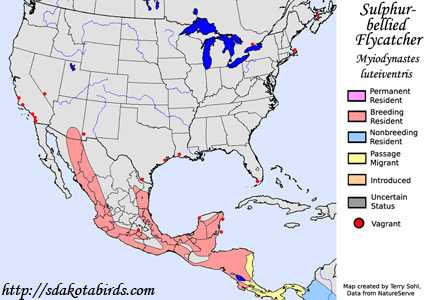| Length: 8.5 inches | Wingspan: 15 inches | Seasonality: Non-resident in South Dakota |
| ID Keys: Strong light and dark head stripes, rufous-colored tail, dark above with barring and markings, light below with streaks on the breast, stout long bill | ||
 The
Sulphur-bellied Flycatcher is a unique tropical flycatcher species with a
breeding range that just crosses into the United States in southeastern
Arizona and southwestern New Mexico. They are unique in both plumage
and structure, with a more compact structure and thicker bill than most
flycatchers, and with a unique, very obvious plumage pattern. They are
long-distance migrants, with birds only found in the United States during
the summer breeding season. Even birds that breed in Mexico and
Central America move to South America for the winter.
The
Sulphur-bellied Flycatcher is a unique tropical flycatcher species with a
breeding range that just crosses into the United States in southeastern
Arizona and southwestern New Mexico. They are unique in both plumage
and structure, with a more compact structure and thicker bill than most
flycatchers, and with a unique, very obvious plumage pattern. They are
long-distance migrants, with birds only found in the United States during
the summer breeding season. Even birds that breed in Mexico and
Central America move to South America for the winter.
Habitat: In the U.S. portion of its range, the Sulphur-bellied Flycatcher is mostly found in wooded, riparian canyons, especially those where sycamores and other tall trees are found. In the rest of their tropical range, they can be found in a variety of woodland habitats.
Diet: Feeds on insects and other small invertebrates. They will also sometimes eat fruits and berries.
Behavior: Forages by observing from a high perch, and flying out to capture flying insects in mid-air. They will also sometimes hover briefly while gleaning insects from vegetation.
Nesting: The nest of a Sulphur-bellied Flycatcher is in a cavity in a tree, either a natural cavity or an old woodpecker hole. The nesting cavity is filled with strips of bark and smalls sticks, and topped with finer material such as pine needles or grass stems. The female lays 3 or 4 eggs, and she alone incubates them. When the eggs hatch, both parents help feed the young. The young fledge at about 18 days.
Song: Has a variety of calls, including a low-pitched ket call that is often given in a repetitive series, and a series of strong squeaky whistles that sounds like a harsh children's squeaky toy.
Migration: Strongly migratory, Sulphur-bellied Flycatchers that breed in North America migrate to South America for the winter.
Interactive eBird map: Click here to access an interactive eBird map of Sulphur bellied Flycatcher sightings
Similar Species: Distinctive, unlikely to be confused with another species in its North American range. Perhaps the Piratic Flycatcher is the bird most likely to be confused with the Sulphur-bellied, but the Piratic Flycatcher is but a rare visitor to the United States.
Conservation Status: Populations are generally stable, they are found over a wide geographic region, and they are common in many parts of their range. The IUCN lists the Sulphur-bellied Flycatcher as a species of "Least Concern".
Further Information: 1) Breeding of the Sulphur-bellied Flycatcher in Arizona
2) Whatbird - Sulphur-bellied Flycatcher
3) Audubon Guide - Sulphur-bellied Flycatcher
Photo Information: Photo taken by Dominic Sherony - Photo licensed under Creative Commons Attribution ShareAlike 2.0 Generic License.
| Click below for a higher-resolution map |
 |
| South Dakota Status: Non-resident in South Dakota |
Additional Sulphur-bellied Flycatcher Photos (coming soon!!)
